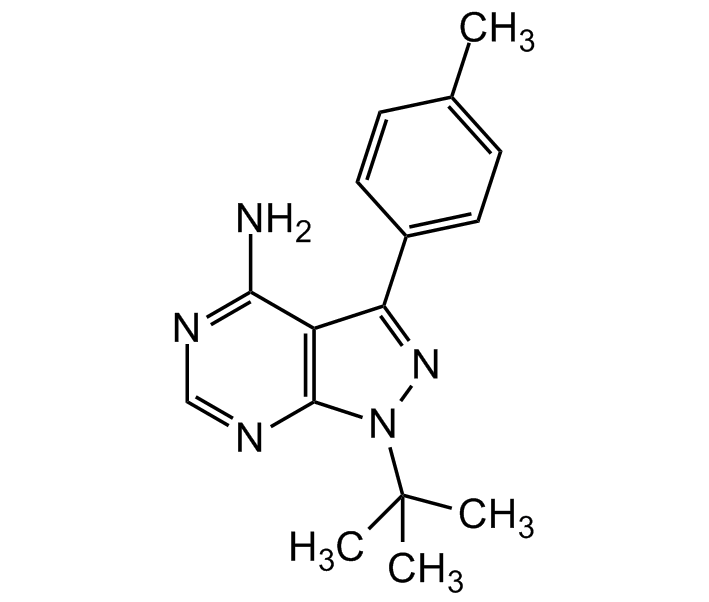
Chemical Structure
PP1 [172889-26-8]

AG-CR1-3562
CAS Number172889-26-8
Product group Chemicals
Estimated Purity>98%
Molecular Weight281.4
Overview
- SupplierAdipoGen Life Sciences
- Product NamePP1 [172889-26-8]
- Delivery Days Customer10
- CAS Number172889-26-8
- CertificationResearch Use Only
- Estimated Purity>98%
- Hazard InformationNon-hazardous,Warning
- Molecular FormulaC16H19N5
- Molecular Weight281.4
- Scientific DescriptionChemical. CAS: 172889-26-8. Formula: C16H19N5. MW: 281.4. Highly potent and selective Scr family tyrosine kinase inhibitor. Shows anti-Ras cancer potential by blocking Ras-induced activation of PAK1. Antitumor compound. RIP2 inhibitor. Blocks TGF-beta-mediated cellular responses. - Highly potent and selective Scr family tyrosine kinase inhibitor [1, 2, 6, 9]. Shows anti-Ras cancer potential by blocking Ras-induced activation of PAK1 [4]. Antitumor compound [3, 4, 5, 7]. RIP2 inhibitor [9]. Blocks TGF-beta-mediated cellular responses [8, 10].
- SMILESCC1=CC=C(C=C1)C1=NN(C2=C1C(N)=NC=N2)C(C)(C)C
- Storage Instruction2°C to 8°C,-20°C
- UNSPSC12352200
References
- Discovery of a novel, potent, and Src family-selective tyrosine kinase inhibitor. Study of Lck- and FynT-dependent T cell activation: J.H. Hanke, et al.; J. Biol. Chem. 271, 695 (1996)
- Src family-selective tyrosine kinase inhibitor, PP1, inhibits both Fc epsilonRI- and Thy-1-mediated activation of rat basophilic leukemia cells: M. Amoui, et al.; Eur. J. Immunol. 27, 1881 (1997)
- Lck associates with and is activated by Kit in a small cell lung cancer cell line: inhibition of SCF-mediated growth by the Src family kinase inhibitor PP1: G.W. Krystal, et al.; Cancer Res. 58, 4660 (1998)
- An anti-Ras cancer potential of PP1, an inhibitor specific for Src family kinases: in vitro and in vivo studies: H. He, et al.; Cancer J. 6, 243 (2000)
- The kinase inhibitor PP1 blocks tumorigenesis induced by RET oncogenes: F. Carlomagno, et al.; Cancer Res. 62, 1077 (2002)
- The specificities of protein kinase inhibitors: an update: J. Bain, et al.; Biochem. J. 371, 199 (2003)
- The Src-selective kinase inhibitor PP1 also inhibits Kit and Bcr-Abl tyrosine kinases: L. Tatton, et al.; J. Biol. Chem. 278, 4847 (2003)
- Src activation is not necessary for transforming growth factor (TGF)-beta-mediated epithelial to mesenchymal transitions (EMT) in mammary epithelial cells. PP1 directly inhibits TGF-beta receptors I and II: M. Maeda, et al.; J. Biol. Chem. 281, 59 (2006)
- The selectivity of protein kinase inhibitors: a further update: J. Bain, et al.; Biochem. J. 408, 297 (2007)
- The Src family kinase inhibitors PP2 and PP1 block TGF-beta1-mediated cellular responses by direct and differential inhibition of type I and type II TGF-beta receptors: H. Ungefroren, et al.; Curr. Cancer Drug Targets 11, 524 (2011)
